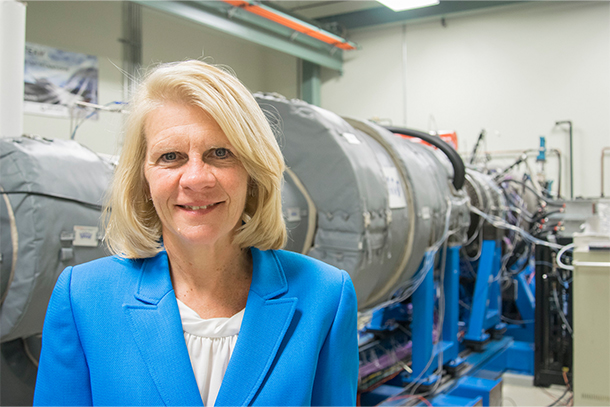
Karen Thole, START Lab director and Distinguished Professor of Mechanical Engineering. Credit: Kate Myers/Penn State College of Engineering. All Rights Reserved.
Propelling the future: A Q&A with START Lab Director Karen Thole
March 15, 2023
By Sarah Small
UNIVERSITY PARK, Pa. — Steady Thermal Aero Research Turbine Lab was founded in 2012 in the Penn State Department of Mechanical Engineering through a partnership with the U.S. Department of Energy National Energy Technology Lab (DOE-NETL) and Pratt & Whitney. The turbine testing facility was designed to perform turbine heat transfer studies, along with instrumentation development and integration of additive manufacturing to increase the speed in advancing turbine research. A $26 million commitment from Pratt & Whitney, the Federal Aviation Administration, the DOE-NETL and Penn State will support the expansion of the START Lab and the creation of START+.
START Lab Director and Penn State Distinguished Professor of Mechanical Engineering Karen Thole answered a few questions about gas turbine technologies, the START Lab and the upcoming expansion.
Q: What are gas turbines, what are they used for and why are they important?
Thole: Gas turbines generate the propulsion needed for airplanes and generate the power needed to meet our electricity needs. Both of these applications are important for different reasons. In the case of aviation, gas turbines are currently the only device that can meet the propulsion needs to power existing aircraft for both commercial and military flight. Although renewable energy continues to increase in the U.S., gas turbines fueled by natural gas provide us with energy security resulting from their stable operations with a great example of such being our own campus here at Penn State. Key to both of these applications are blade life, which dictates how often these parts need to be replaced, and stage efficiency, which dictates the amount of fuel required to operate. Increased fuel amounts lead to increased carbon dioxide in the atmosphere, which is what we need to reduce.
Q: What are some of the biggest or most interesting accomplishments of START to date, from your perspective?
Thole: The research that we have been able to do in START has impacted turbine cooling technologies. Turbine inlet temperatures greatly exceed those of the melting temperatures of the blades and vanes, resulting in the need for cooling. We have evaluated different cooling technologies, and, through these measurements, we have extended blade life for operations. One of the most interesting studies we just completed was to measure blade temperatures and turbine efficiencies for blades taken out of turbines that have flown in different parts of the world. Through this NASA HyTEC Program, we learned so much about the ways in which different pilots operate and how the environment can impact the blades.
Another accomplishment has come from the support of the Department of Energy in partnership with Honeywell, Pratt and Whitney, Siemens and Solar Turbines in which our team designed the National Experimental Turbine (NExT). NExT is a turbine test bed for our partners to use cheaper and faster in developing new technologies. And, in the past few months, one of our biggest accomplishments was to spin our first additively manufactured (3D metal printed) NExT blades. This accomplishment has led to us being able to develop and test cooling geometries much faster than having to wait for conventionally cast turbine blades.
Q: What are some of the research goals and projects that will be pursued with this expansion?
Thole: With a continued push to meet the U.S. Climate Action Plan, we need to be net-zero carbon. For power generation, the U.S. is pushing toward using hydrogen to replace natural gas and to further increase turbine inlet temperatures. For aviation, several options are on the table, including using sustainable aviation fuels in the near term and further out in time developing new architectures such as hybrid electric propulsion, such as a Prius flying through the sky. For all of these options, the turbine is key, and the efficiency in which it’s able to convert fuel to shaft power while balancing component life will drive our ability to be successful in reducing the climate impacts. This is the heart of what our new lab expansion is all about.
Q: How does the START Lab expansion differ from START?
Thole: The expansion of our existing START Lab means that we will install the needed infrastructure to be able to test new, high-temperature materials such as ceramic matrix composites (CMCs). These CMCs are one means of reducing the amount of cooling necessary for the airfoils and that results in increased efficiencies.
START+ will add even more infrastructure and a brand-new test turbine making two facilities at Penn State. This second turbine will be smaller in diameter but will have a second stage of vanes and blades. The push toward smaller turbine cores is important in reducing the overall weight of the turbine and allowing for higher by-pass ratios leading to higher propulsion efficiencies.
Q: How has the collaboration between Penn State, government and industry benefitted the research?
Thole: Without our government and industry partners, our research would not be possible. The long-term collaborations and support from Pratt and Whitney and the Department of Energy have led to experimental findings that don’t just sit on a shelf somewhere or in a publication. Our research results quickly transition to industry. In turn, the government agencies are directly impacting the economy and security of our country. This happens because of our collaborations from day one. And it’s not only our research; it is the fact that our students are being given the opportunity to work on today’s challenges while interacting with engineers in the field. And, once they finish their degrees, they often become gainfully employed by our industry partners. We are so thankful to Pratt and Whitney, the FAA ASCENT Program, the Department of Energy-National Energy Technology Lab and Penn State for giving our START Lab this opportunity to make a difference.



